Translations:
Other Pages:
CEC Training Modules
Akan Studies Site Map
Sociology for beginners
Contact
Kompan Adepa
Go to the People
Ghana Web
Men and Women; (2) Abe (Oil Palm)
Farming and Oil
by Phil Bartle, PhD
The oil palm (abe) has thirty (ie many or uncountable) uses. You can not taboo the oil palm; you will always touch it.
─Akan proverb─
- Men and Women; (1) Oil Palm; Introduction and Conclusion
- Men and Women; (2) Oil Palm; Farming, Oil
- Men and Women; (3) Oil Palm; Wine Tapping
- Men and Women; (4) Oil Palm; Wine Marketting
- Men and Women; (5) Oil Palm; Other Products
Farming:
Most –– about 90 per cent –– of the farming is done by women. It is associated with the red or earth (Asaase Yaa, Woman God, Mother Nature, born on Thursday) and with women's role of providing food and nurturing.
Farming was adapted and appropriate to the rain forest. The huge trees provided protection against destructive rain storms, shade against the tropical sun, and they inhibited too much evaporation. Crops are mixed, and that helps to slow down the spread of parasites which tend to be species specific.
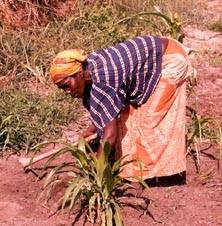 |
Farming
Men did help farming by clearing the heavy brush and trees, and got more involved after the introduction of tractors and cash crops (which ruined the soil). Historically, their productive role was in hunting and fishing.
 |
Pra River Station
A farmer with palm branch basket on her head, nearby a young palm tree.
This farmer is standing next to a young abe tree, perhaps eight months old. On her head is a basket made from abe branches. Difficult to see, but in the back, on the right, is a cocoa tree. The cocoa pods do not grow on branches, but directly off the trunk of the tree. Like the abe, it needs the protection of the huge rain forest hardwoods. With the destruction of the hardwoods, caused by the lumber industry, for lucrative sale on the international markets, and often organized by European entrepreneurs, much of the abe and cocoa is disappearing.
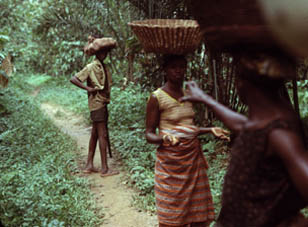 |
Farmers chatting while meeting each other on a rain forest pathway
The palm tree (Elaeis Guinnesis Jacq) does not stop growing. it simply gets taller. If you ever get to Kampala, Uganda, and visit the Bahai temple, you will see a dozen or so palm trees growing on its beautiful garden. A delegation of Bahai visitors came to visit from Ghana in the fifties, and planted some palm kernels. The growing and eating of abe never caught on in Uganda, so no one gathered the crop or cut down the trees for the sap. They are now about 30-35 metres high, looking like some disfigured coconut or ornamental palms.
In West Africa, the women who grow abe cut the branches and take off the fruit so long as they can reach them.
For the Akan, the land is owned corporately by the abusua (matrilineage), never by an individual. The lineage does not sell the land, and individuals are allocated usufruct (usage) rights by the elders of the abusua. Each tree, in contrast, is owned by the woman who grows it, and she has the right to sell it.
Extracting Palm Oils
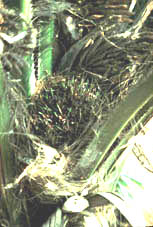 |
The fruit of the oil palm grow in bunches on the top of each tree.
The palm kernels grow in bunches at the top of the tree. When unripe, they are black, but as they ripen they turn red. When they are black, they are considered the property of God and in a state of transition (see Three Souls).
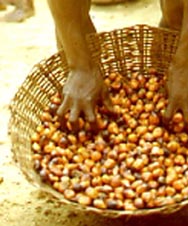 |
Red Palm Kernels
Archaeologists, digging in the caves, which are now always occupied by ancient gods, but were at one time human residences, have traced the changes of the palm kernels. (The heavy rainfall makes it difficult for archaeologists to dig anywhere else than caves in the rain forest). As with maize cobs in central America, the earliest indigenous (wild) palm kernels were very small. By selective breeding over the centuries, the domesticated kernels became larger and larger. The trees now are dependent upon humans for their propagation and care.
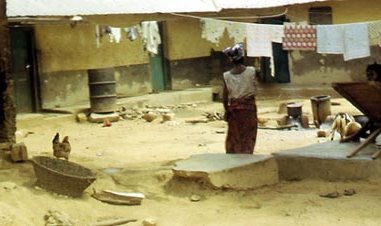 |
Subeng
This women will extract two oils from the palm in her compound
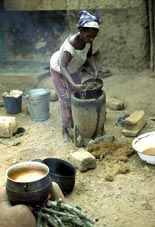 |
Extracting palm oil from the kernels
The woman boils and pounds the kernels to produce a liquid composed of water and palm oil. She uses a mortar and pestle to pound the kernels. She sieves the pounded kernels to separate the liquid from the fibre, which can be seen on the ground here. Her sieve is a calabash with holes in it.
In Akan, the word for "red" covers a much wider range of shades and tints than in English. It can range from burnt umber, brown, rust and even slightly purple, to blood red colour.
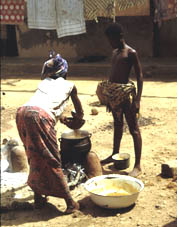 |
Daughters Learn from Mothers
Although abe is indigenous to West Africa, Europeans found the oil useful, and have started plantations around the world. South East Asia and South America are areas where oil palm trees are grown on large commercial plantations. The oil is used commercially for making a wide range of products, including margarine and detergents. There are a few large abe plantations in Ghana, but most were not commercially successful.
The inner kernels, which are black, are dried in the sun for about two weeks, and then cracked open. Inside is a yellow oil, used for different purposes and different recipes. Also is a hard white meat which is reminiscent of coconut meat, but much tougher.
After removing the red oil, meat and yellow oil, the women may sell the dried kernels to a blacksmith or a charcoal maker. Charcoal made with the inner kernel shells is very clean and hot burning, and is very popular with blacksmiths.
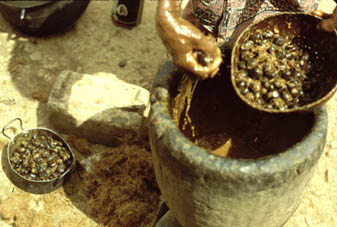 |
Using a sieve to remove the liquid from the fibre and inner kernels
At some time, the tree is too high for the owner to gather the palm kernels and cut the branches. There is an overall cultural tension between women, who farm the trees for their kernels, and men, who want the trees for their sap. Often a man can convince a women to sell him the tree earlier than she might otherwise prefer, and so the production shifts from "red" to "white."
The abe has thirty (many, uncountable) uses.